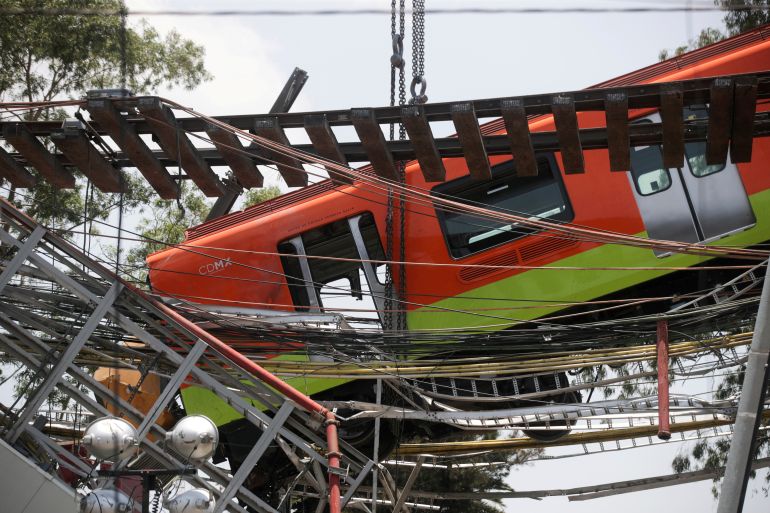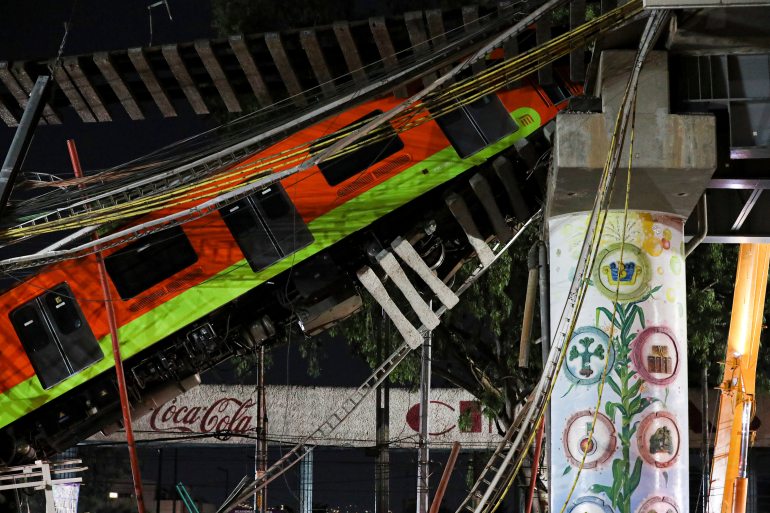Missing bolts contributed to Mexico City metro collapse: Report
Poor welding also contributed to Metro Line 12 collapse that killed 26 people in May, independent auditor finds.

A deadly Mexico City metro collapse in May was caused in part by missing bolts in the beams of an overpass that already had deficiencies before an important earthquake, an independent auditor’s report released on Tuesday by the city government has found.
The 180-page analysis by Norwegian company DNV was the latest instalment of its technical opinion on the May 3 collapse – Mexico’s biggest train accident in years.
Keep reading
list of 3 itemsMexico faces migration crises on northern, southern borders
Large oil spill in Gulf of Mexico after Ida, clean-up under way
Twenty-six people were killed when an overpass and train carriage on Metro Line 12 suddenly plummeted onto a stream of cars near the Olivos station in the city’s southeast.
The collapse put pressure on close allies of President Andres Manuel Lopez Obrador, as well as on Carlos Slim, Latin America’s richest man whose construction company was responsible for building the part of the line that collapsed.
In the second phase of DNV’s findings shared by city officials, the firm said deficiencies, including a lack of functional bolts over a significant stretch of the line, led to the buckling of north and south beams.
The deficiencies left the structure operating as two independent girders that took on weight it was not designed to handle.
“This created conditions that led to the distortion of the central transverse frame and the initiation and propagation of fatigue cracks that further reduced the capacity of the structure to support the load,” the report said.
The firm said other possible factors included deficiencies in the beams themselves and the design of the framework.
Sections of the collapsed overpass were in “compromised condition” before a serious 2017 earthquake that caused damage to parts of the metro, the report said. Poor welding practices were also observed by the auditor.
The city government has already started working on rehabilitation of the line, and the report’s findings will be shared with a technical advisory committee, said Jesus Esteva, head of Mexico City’s public works department.
“In the next few days we will be signing the agreements with the companies. They will be doing the work,” Esteva said, without adding further details.

The metro was built by a consortium of Mexico’s ICA, Grupo Carso, a company controlled by Slim’s family, and French train maker Alstom SA.
Grupo Carso had no immediate comment on the report, nor did ICA respond to a request by the Reuters news agency for comment while a representative for Alstom could not be reached.
Carso would repair the line at no cost to the government so that it can reopen in a year, Lopez Obrador said in June.
DNV’s initial report found “six deficiencies in the construction process” that contributed to the accident and noted inadequate bolts and deformed structural supports.
The firm had been due to present its follow-up report on August 23 but requested a two-week extension to complete its investigation. The company is still expected to deliver a third phase of its findings on what happened.
Local media reported that the expert analysis had cost Mexico City more than $1m.